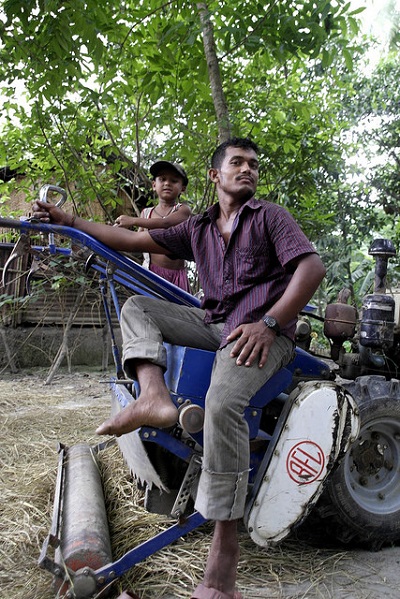
El Batan, MEXICO (CIMMYT) – A new study by scientists at The International Wheat and Maize Improvement Center (CIMMYT) looks at large-scale adoption practices of agricultural machinery appropriate for smallholder farmers in Bangladesh, concluding that sustained emphasis on improving infrastructure, services and assuring credit availability is necessary to facilitate adoption.
There is strong advocacy for agricultural machinery appropriate for smallholder farmers in South Asia. Such “scale-appropriate” machinery can increase returns to land and labor, but high capital investment costs make it hard for farmers to own these machines. Increasing machinery demand has resulted in relatively well-developed markets for rental services for tillage, irrigation, and post-harvest operations.
Studying households that own machinery can provide insights into the factors that facilitate or limit adoption, which can help development planners, policy makers and national and international banks to target investments more appropriately. The study “Factors associated with small-scale agricultural machinery adoption in Bangladesh: census findings,” is the first recent study to examine these practices at large scale, using the case of Bangladesh.
The paper examines the adoption information gap in Bangladesh by reviewing the country’s historical policy environment that facilitated the development of agricultural machinery markets. It then uses recent Bangladesh census data from over 800,000 farm households to identify variables associated with the adoption of the most common smallholder agricultural machinery like irrigation pumps, threshers and power tillers.
Results of the study indicate that machinery ownership is positively associated with household assets, credit availability, electrification, and road density. These findings suggest that donors and policy makers should focus not only on short-term projects to boost machinery adoption, but also emphasize improving physical and civil infrastructure and services, as well as assuring credit availability to facilitate the adoption of scale-appropriate farm machinery.
Check out this study and other recent publications from CIMMYT researchers, below:
- 13C Natural Abundance of Serum Retinol Is a Novel Biomarker for Evaluating Provitamin A Carotenoid-Biofortified Maize Consumption in Male Mongolian Gerbils. 2016. Gannon, B.; Pungarcher, I.; Mourao, L.; Davis, C.R.; Simon, P.; Pixley, K.V.; Tanumihardjo, S.A. The Journal of Nutrition 146 : 1290-1297.
- Does closing knowledge gaps close yield gaps? On-farm conservation agriculture trials and adoption dynamics in three smallholder farming areas in Zimbabwe. 2016. Cheesman, S.; Andersson, J.A.; Frossard, E. Journal of Agricultural Science. Online First.
- Factors associated with small-scale agricultural machinery adoption in Bangladesh : census findings. 2016. Mottaleb, K.A.; Krupnik, T.J.; Erenstein, O. Journal of Rural Studies 46 : 155-168.
- Fertilization strategies in Conservation Agriculture systems with Maize-Legume cover crops rotations in Southern Africa. 2016. Mupangwa, W.; Thierfelder, C.; Ngwira, A. Experimental Agriculture. Online First.
- High temperatures around flowering in maize: effects on photosynthesis and grain yield in three genotypes. 2016. Neiff, N.;Trachsel, S.; Valentinuz, O.R.; Balbi, C.N.; Andrade, H.F. Crop Science 56 : 1-11.
- Kenyan Isolates of Puccinia graminis f. sp. tritici from 2008 to 2014 : virulence to SrTmp in the Ug99 race group and implications for breeding programs. 2016. Newcomb, M.; Olivera Firpo, P.D.; Rouse, M.N.; Szabo, L.J.; Johnson, J.; Gale, S.; Luster, D.G.; Wanyera, R.; Macharia, G.; Bhavani, S.; Hodson, D.P.; Patpour, M.; Hovmoller, M.S.; Fetch, T.G.; Yue Jin. Phytopathology 106 (7) : 729-736.
- Targeting drought-tolerant maize varieties in Southern Africa : a geospatial crop modeling approach using big data. 2016. Kindie Tesfaye Fantaye; Sonder, K.; Cairns, J.E.; Magorokosho, C.; Amsal Tesfaye Tarekegne; Kassie, G.; Getaneh, F.; Abdoulaye, T.; Tsedeke Abate; Erenstein, O. The International Food and Agribusiness Management Review 19 : 75-92.
- The adoption problem; or why we still understand so little about technological change in African agriculture. 2016. Glover, D.; Sumberg, J.; Andersson, J.A. Outlook on Agriculture 45 (1): 3-6.
- The effect of major income sources on rural household food (in)security : evidence from Swaziland and implications for policy. 2016. Mabuza, M.L.; Ortmann, G.F.; Wale, E.; Mutenje, M. Ecology of Food and Nutrition 55 (2) : 209-230.
- Weed management in maize using crop competition: a review. 2016. Mhlanga, B.; Chauhan, B.S.; Thierfelder, C. Crop Protection 88: 28-36.
 Capacity development
Capacity development